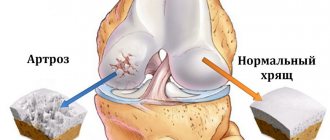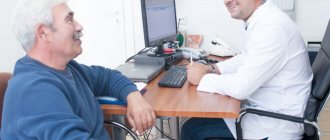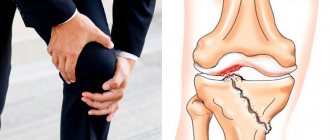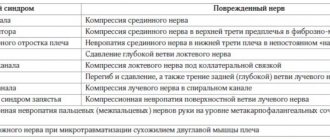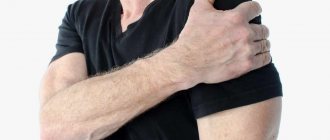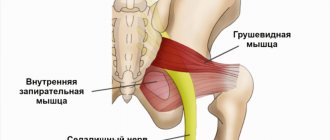General information
Sudeck's disease is a pain syndrome caused by injuries to the extremities, which develops against the background of long-term vasomotor, trophic impairment and painful osteoporosis . The main cause is a complicated fracture of the radius , in approximately 10-40% of cases, but it can also affect the lower extremities.
The first description of the syndrome belongs to the German surgeon Paul Sudeck, who back in 1900 gave it the name acute trophoneurotic bone atrophy and identified characteristic radiological signs - the presence of transparency in the bone pattern against the background of various inflammatory diseases of the osteoarticular system, characterized by rapidly developing atrophy of bone tissue.
Sudeck syndrome of the lower limb
In addition, Marie Rene Leriche was involved in the study and description of this clinical and radiological syndrome. At the initiative of the International Association for the Study of Pain , scientists in 1996 combined “reflex sympathetic dystrophy”, “post-traumatic dystrophy of the hand”, “ algoneurodystrophy ”, “shoulder-hand” syndrome, “ causalgia ” and other terms denoting Sudeck’s disease into a single concept and was called complex regional pain syndrome (CRPS) .
Literature
- M. G. Astapenko, P. S. Eryalis. Extra-articular diseases of soft tissues of the musculoskeletal system. M., p. 124, 1975
- Levina R. E., Kipervas I. P., Budunova L. V. Experience in treating patients with Sudeck syndrome in an outpatient rehabilitation department, Issues of balneology, physiotherapy. Vol. No. 6, p. 67, 1989
- Shamov I.
Sudeck syndrome. // “Medical newspaper”, No. 24, 2012. p. 9. - Sudeck's syndrome. Per. from English N. D. Firsova. (2019).
- Leitlinie "Diagnostik und Therapie komplexer regionaler Schmerzsyndrome (CRPS)" der DGN
- RN Harden, M. Swan ua: Treatment of Complex Regional Pain Syndrome: Functional Restoration.
In:
Clinical Journal of Pain.
2006 Jun, 22 (5), S. 420—424. - DV Nelson, BR Stacey: Interventional Therapies in the Management of Complex Regional Pain Syndrome.
In:
Clinical Journal of Pain.
2006 Jun, 22 (5), S. 438-442. - J. Klingelhöfer, M. Rentrop: Klinikleitfaden "Neurologie, Psychiatrie".
S. 252. - Interne Fortbildung der Abteilung für Neurologie
. Landgrebe, Krankenhaus der BB R., April 2005. - F. U. Niethard, J. Pfeil: Orthopädie.
4. Auflage. 2003, ISBN 3-13-130814-1. - Thomas von Rothkirch, Walter Blauth, Bodo Helbig: Das Sudeck-Syndrom der Hand.
Überblick, Behandlungskonzept und Ergebnisse . Handchirurgie, Mikrochirurgie und Plastische Chirurgie 21 (1989), S. 115-126. - G. Wasner, J. Schattschneider ua: Das komplexe regionale Schmerzsyndrome.
In:
Der Anaesthesist.
2003 Oct, 0(10), S. 883-895. - M. Rizzo, SS Balderson, DH Harpole, LS Levin: Thoracoscopic sympathectomy in the management of vasomotor disturbances and complex regional pain syndrome of the hand.
In:
Orthopedics.
Januar 2004, 27 (1), S. 49-52. - Heilung am Rande des Todes.
In:
Bild der Wissenschaft.
8/2006.
Pathogenesis
P. Zudek noted the leading importance of local autonomic reactions and vasomotor disorders in the development of atrophy and any even minor injuries. For successful restoration and activation of the correct circuit of compensatory mechanisms of the body, the selection of the correct treatment strategy is very important.
The development of acidosis , metabolic disorders, the occurrence of stasis and oxygen starvation occurs with long-term painful stimuli, infections, tissue swelling, which lead to metabolic disorders, tissue acidosis and increased tone of sympathetic innervation, narrowing of capillary vessels and oxygen starvation. An increase in the tone of the sympathetic nerve can be fixed and become independent of the initial source of irritation.
The basis of the pathological process is the predominance of degeneration processes over regeneration, entailing the proliferation of connective tissue structures. Against this background, additional irritation of the sympathetic nerve and the subsequent development of a secondary vicious circle may occur. In the process, all secondary phenomena can acquire independent significance and mutual influence, causing stage-by-stage changes in the bone apparatus.
Vicious circle of pathophysiology of Sudeck syndrome
Stages of Sudeck syndrome
R. Krigkoff proposed dividing neurodystrophic syndrome into 3 stages:
- Acute inflammation - the stage of vasomotor disorder and chronic inflammation ( algic ) occurs approximately 2 weeks after injury and causes a sharp resumption and intensification of pain that has already subsided, they are usually widespread and cover the entire affected segment, if the upper limb is affected, then swelling of the hand develops with fingers, their redness, increased temperature, stiffness of movements, decreased range of passive movements and pain.
- The dystrophic stage usually lasts - 2-4 or more months - trophic disorders cause progression of swelling and limited mobility of the fingers against the background of persistent pain, then subcutaneous fat atrophies and the skin becomes thin, pale or gray-cyanotic, with increased sweating, areas hyperkeratosis (mainly on the palmar side of the fingers) and excess hair, the local temperature stabilizes and equalizes.
- Atrophy is a severely disabling condition, rarely treatable, occurs after the disappearance of swelling against the background of pain, pallor, thinness and coldness of the skin, as well as hypertrichosis and hyperkeratosis, while the growth of nails increases, but they are fragile and brittle, prone to darkening, in the process of atrophy involves muscles (due to increased excretion of calcium , hydroxyproline and creatinine ), which provokes their weakness, inability to move the fingers, adduction of one of them and the constant position of the rest in a slightly bent state.
As a result of the involvement of the skeletal system in the pathological process, the well-known spotted bone atrophy develops, and the following also occurs:
- severe functional and anatomical disorders;
- fibrosis of the sliding component of the tendon apparatus;
- hardening of joints;
- rarefaction (thinness) of bones and trophic disturbances;
- myoosteofibrosis.
Development mechanism
Any injury, to one degree or another, negatively affects the functioning of the autonomic nervous system. With proper treatment, timely and consistent rehabilitation measures, complete recovery occurs. This happens due to the adaptive capabilities of the body.
If an external stimulus acts for a long time, the function of the autonomic nervous system does not have time to recover. As a result of ongoing pain, swelling and infection, the sympathetic nerve is in a state of hypertonicity, which becomes permanent and no longer depends on the root cause of the irritation. Small capillaries narrow, blood flow slows down, and tissues lack oxygen.
Due to disruption of interstitial metabolism, degenerative processes begin to prevail over regenerative processes, and connective tissue grows. Connective tissue scars further irritate the nerve, creating a vicious circle.
The progress of the pathological process leads to thinning of bone tissue, fibrous degeneration of tendons, stiffness of joints and persistent disruption of trophism - cellular nutrition.
Causes
Sudeck's dystrophy occurs more often in elderly patients and, to a greater extent, in women with vegetative or hormonal imbalances. Pathology is a nonspecific pathological reaction of the neurovascular system in response to changes in soft tissues and bones caused by disorders of the nervous system, injuries, burns, frostbite, inflammation, thrombosis and other pathological conditions. Neurodystrophic processes can be caused by even such minor injuries as a dislocation or a prick with a sharp object, therefore it is believed that genetic predisposition also plays a role in etiogenesis. The etiogenesis of Sudeck syndrome also lies in:
- Iatrogenesis - dystrophy develops as a result of improper or erroneous treatment, violations of the principles of rehabilitation and insufficient immobilization (immobilization) after fractures , as well as improper treatment of phlegmons of the palms of the hands in elderly people;
- early physical activity and active movements of the injured limb;
- hot procedures, performing rough rehabilitation passive movements and massage.
Treatment
Treatment is usually conservative. In the initial stage, drug therapy is carried out (analgesic and vasodilator drugs, muscle relaxants, B vitamins, anabolic hormones, etc.), which is combined with hyperbaric oxygenation (see “Hyperbaric oxygenation”), acupuncture (see “Reflexotherapy”), laser therapy and others. In order to normalize calcium metabolism, calcitrin is prescribed. If there is no effect, novocaine blockades are sometimes performed (see “Novocaine blockade”) or sympathectomy (see “Functional neurosurgery”). After reducing the intensity of the pain syndrome, physiotherapy, physical therapy, and massage are prescribed. The use of intense thermal procedures and gross violent manipulations, such as redressing, should be avoided, as this causes an exacerbation of the pathological process. The prognosis for organ function is not always favorable.
Symptoms
Neurodystrophic Sudeck syndrome, caused by impaired microcirculation of the affected segment, is manifested by the resumption or intensification of pain some time after treatment of injuries, usually accompanied by vasomotor and trophic disorders in the tissues of the affected segment of the limb, for example, after a fracture of the radius of the arm. Symptoms of Sudeck syndrome consist of a number of local clinical manifestations caused by reflex-tonic (local spastic) disorders:
- intense pain syndrome that spreads (later causes “arm-shoulder” syndrome) and intensifies with the slightest movements and touches, does not disappear with immobilization, causes a sharp limitation of mobility, stiffness and contractures;
- rapidly developing dense diffuse type edema;
- change in the condition of the skin - first to warm and hyperemic, then to cold and cyanotic, called marbled skin;
- gradual thinning of the skin, the appearance of a shiny surface and loss of folding structure;
- atrophy of muscle structures and subcutaneous tissue;
- spotted “piebald” uneven osteoporotic changes in bone tissue, which are revealed by radiography;
- fragile, brittle and also thinning nails and hair.
Most often, Sudeck syndrome is observed after a fracture of the radius of the arm, which is fraught with the development of median nerve compression syndrome. Pain reminiscent of causalgia makes patients restless, anxious, they are constantly focused on the diseased limb and try to protect it from touch and movement.
Tests and diagnostics
To make a diagnosis, it is necessary to take radiographs of the healthy and affected limb in direct projections. Typical radiological signs include:
- spotty post-traumatic osteoporosis , affecting mainly the distal metaphyses of the metacarpal bones and phalanges of the fingers and making them very distinct;
- narrowing of interarticular spaces;
- As the pathology develops, the bone structure becomes glassy.
Additional studies may be needed to establish the condition of the vascular network, muscles and temperature indicators.
Diet for Sudeck syndrome
Diet for osteoporosis
- Efficacy: therapeutic effect, high efficiency
- Terms: 1-3 months
- Cost of food: 2180 - 2260 rubles per week
The pathology is based on capillary-trophic insufficiency, which causes metabolic disorders, blood stagnation, muscle weakness and osteoporosis , so it is very important to maintain a high level of metabolism, provide the body with calcium in full, improve blood properties and support the immune system. For this purpose, the menu is built on the basis of such products as:
- cheeses, cottage cheese, yoghurts, milk and lactic acid drinks;
- dietary meats;
- seafood, including seaweed;
- nuts and seeds, such as sunflower or pumpkin;
- cereals and cereals;
- vegetables, legumes and greens;
- fruits and berries.
Prevention
The main preventive actions are:
- correct fixation period;
- early physical therapy;
- painless manipulation;
- light load.
However, the difficulty of prevention lies in the lack of assessment of the significance of each of the many factors that cause this complication. To avoid further complications of Sudeck syndrome, recurrent injuries should be closely monitored. At the first exacerbations, you must immediately seek help from a specialized institution. Only a timely visit to a doctor will help avoid possible negative consequences.
Similar syndromes:

